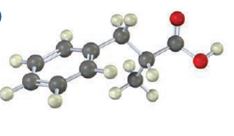
a)

Interpretation:
The steps involved in preparing the compound represented by the model, using either malonic ester synthesis or an acetoacetic ester synthesis, are to be given.
Concept introduction:
Acetoacetic ester synthesis converts an
Both reactions involve the same steps such as i) enolate ion formation ii) SN2 attack of the enolate anion on the alkyl halide iii) hydrolysis and decarboxylation.
Answer to Problem 17VC
The steps involved in preparing the compound represented by the model using acetoacetic ester synthesis are given below.

Explanation of Solution
The compound represented by the model is 6-methylhept-5-ene-2-one. It is a methyl ketone and hence it can be prepared using acetoacetic ester synthesis. The ethoxide ion abstracts a proton from the active methylene group of the ester to form the enolate ion. The enolate ion then attacks 1-bromo-3-methy-2-butene and displaces the bromine as bromide ion. The product obtained upon hydrolysis with dilute acids and decarboxylation by heating yields the product.
The steps involved in preparing the compound represented by the model using acetoacetic ester synthesis are given below.

b)

Interpretation:
The steps involved in preparing the compound represented by the model using either malonic ester synthesis or an acetoacetic ester synthesis are to be given.
Concept introduction:
Acetoacetic ester synthesis converts an alkyl halide in to a methyl ketone having three more carbons. The methyl ketone part comes from acetoacetic eater while the remaining carbon comes from the primary alkyl halide. Malonic ester synthesis converts an alkyl halide to a carboxylic acid having two more carbon atoms.
Both reactions involve the same steps such as i) enolate ion formation ii) SN2 attack of the enolate anion on the alkyl halide iii) hydrolysis and decarboxylation.
Answer to Problem 17VC
The steps involved in preparing the compound represented by the model using malonic ester synthesis are given below.

Explanation of Solution
The compound represented by the model is 2-methyl-3-phenylpropanoic acid and hence it can be prepared using malonic ester synthesis. The ethoxide ion abstracts a proton from the active methylene group to form the enolate ion. The enolate ion then attacks benzyl bromide and displaces the bromine as bromide ion. The abstraction of another acidic hydrogen in the product by the base and the nucleophilic displacement of bromine from methyl bromide by enolate ion introduces a methyl group at α- position of the diester. The alkylated diester obtained upon hydrolysis with aqueous acids and decarboxylation by heating yields the product.
The steps involved in preparing the compound represented by the model using malonic ester synthesis are given below.

Want to see more full solutions like this?
Chapter 22 Solutions
OWLv2 with Student Solutions Manual eBook, 4 terms (24 months) Printed Access Card for McMurry's Organic Chemistry, 9th
- 4. Read paragraph 4.15 from your textbook, use your calculated lattice energy values for CuO, CuCO3 and Cu(OH)2 an explain thermal decomposition reaction of malachite: Cu2CO3(OH)2 →2CuO + H2O + CO2 (3 points)arrow_forwardPlease sirrr soollveee these parts pleaseeee and thank youuuuuarrow_forwardIII O Organic Chemistry Using wedges and dashes in skeletal structures Draw a skeletal ("line") structure for each of the molecules below. Be sure your structures show the important difference between the molecules. key O O O O O CHON Cl jiii iiiiiiii You can drag the slider to rotate the molecules. Explanation Check Click and drag to start drawing a structure. Q Search X G ©2025 McGraw Hill LLC. All Rights Reserved. Terms of Use F 3 W C 3/5arrow_forward
- 3. Use Kapustinskii's equation and data from Table 4.10 in your textbook to calculate lattice energies of Cu(OH)2 and CuCO3 (4 points)arrow_forward2. Copper (II) oxide crystalizes in monoclinic unit cell (included below; blue spheres 2+ represent Cu²+, red - O²-). Use Kapustinski's equation (4.5) to calculate lattice energy for CuO. You will need some data from Resource section of your textbook (p.901). (4 points) CuOarrow_forwardWhat is the IUPAC name of the following compound? OH (2S, 4R)-4-chloropentan-2-ol O (2R, 4R)-4-chloropentan-2-ol O (2R, 4S)-4-chloropentan-2-ol O(2S, 4S)-4-chloropentan-2-olarrow_forward
- Use the reaction coordinate diagram to answer the below questions. Type your answers into the answer box for each question. (Watch your spelling) Energy A B C D Reaction coordinate E A) Is the reaction step going from D to F endothermic or exothermic? A F G B) Does point D represent a reactant, product, intermediate or transition state? A/ C) Which step (step 1 or step 2) is the rate determining step? Aarrow_forward1. Using radii from Resource section 1 (p.901) and Born-Lande equation, calculate the lattice energy for PbS, which crystallizes in the NaCl structure. Then, use the Born-Haber cycle to obtain the value of lattice energy for PbS. You will need the following data following data: AH Pb(g) = 196 kJ/mol; AHƒ PbS = −98 kJ/mol; electron affinities for S(g)→S¯(g) is -201 kJ/mol; S¯(g) (g) is 640kJ/mol. Ionization energies for Pb are listed in Resource section 2, p.903. Remember that enthalpies of formation are calculated beginning with the elements in their standard states (S8 for sulfur). The formation of S2, AHF: S2 (g) = 535 kJ/mol. Compare the two values, and explain the difference. (8 points)arrow_forwardIn the answer box, type the number of maximum stereoisomers possible for the following compound. A H H COH OH = H C Br H.C OH CHarrow_forward

 Organic ChemistryChemistryISBN:9781305580350Author:William H. Brown, Brent L. Iverson, Eric Anslyn, Christopher S. FootePublisher:Cengage Learning
Organic ChemistryChemistryISBN:9781305580350Author:William H. Brown, Brent L. Iverson, Eric Anslyn, Christopher S. FootePublisher:Cengage Learning

